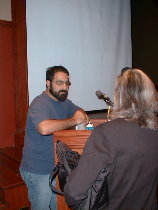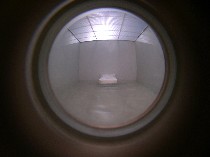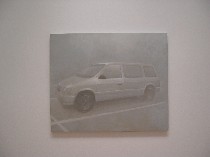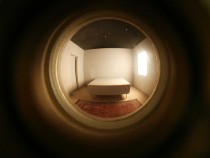 Mark Shetabi’s mysterious paintings and peephole installations made me want to hear what he had to say about them. So I joined a crowd of about 40 art lovers (mostly students) at the Pennsylvania Academy of Fine Arts last week.
Mark Shetabi’s mysterious paintings and peephole installations made me want to hear what he had to say about them. So I joined a crowd of about 40 art lovers (mostly students) at the Pennsylvania Academy of Fine Arts last week.
Shetabi’s family is from Iran, but he was born in New York. The family moved to Iran in 1974, and came back to the United States just before the revolution. Shetabi said his work explored “ideas of my own (Irani) culture, looking through a Western lens.”
 Happily, Shetabi’s talk did not demystify the work. Even after I learned that his “Wet Interior” (shown) showed a real sink with real water–“I get most of my art materials at Home Depot these days,” Shetabi said–the work lost none of its suggestive and atmospheric qualities. The knowledge of the nuts-and-bolts of construction didn’t undermine what Shetabi called the “slippery relationship scale has to the viewer” — or the slippery relationship to reality.
Happily, Shetabi’s talk did not demystify the work. Even after I learned that his “Wet Interior” (shown) showed a real sink with real water–“I get most of my art materials at Home Depot these days,” Shetabi said–the work lost none of its suggestive and atmospheric qualities. The knowledge of the nuts-and-bolts of construction didn’t undermine what Shetabi called the “slippery relationship scale has to the viewer” — or the slippery relationship to reality.
The pieces, their Edward Hopperesque light suggesting a world longed for beyond the darkened forespace, invite the viewer to make up stories about the sets.
 Shetabi’s paintings are–like the sink in “Wet Interior”–icons of the modern world. A portrait of his car, a Plymouth Voyager (shown), seems to be a self-portrait of someone who travels between two cultures and who can admire, in all sincerity, the “contemplative quality of parking garage construction.”
Shetabi’s paintings are–like the sink in “Wet Interior”–icons of the modern world. A portrait of his car, a Plymouth Voyager (shown), seems to be a self-portrait of someone who travels between two cultures and who can admire, in all sincerity, the “contemplative quality of parking garage construction.”
 Shetabi’s love affair with cars shows up in a number of other pieces. In the “Bedroom,” which showed earlier this year at Locks Gallery and White Columns (in New York), the lights and sounds of cars zooming by on I-95 create part of the romance of the unpopulated room. And the peephole view of his childhood home in Iran has a driveway foreground. Shetabi said he liked the meditative time of his commute in the car to New Jersey–a time when the technology of the West opens up the East of the mind .
Shetabi’s love affair with cars shows up in a number of other pieces. In the “Bedroom,” which showed earlier this year at Locks Gallery and White Columns (in New York), the lights and sounds of cars zooming by on I-95 create part of the romance of the unpopulated room. And the peephole view of his childhood home in Iran has a driveway foreground. Shetabi said he liked the meditative time of his commute in the car to New Jersey–a time when the technology of the West opens up the East of the mind .
Shetabi’s talk was the first in an almost weekly series of art-at-lunch talks at PAFA.









